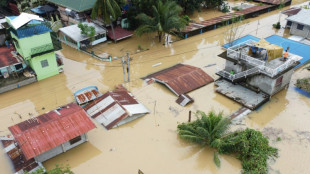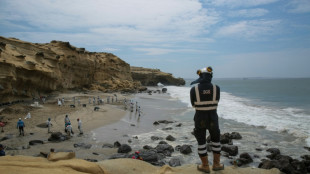
-
 Gaza hospital shut after Israeli raid, director held: health officials
Gaza hospital shut after Israeli raid, director held: health officials
-
Surgery for French skier Sarrazin 'went well': federation

-
 Mitchell, Bracewell boost New Zealand in Sri Lanka T20
Mitchell, Bracewell boost New Zealand in Sri Lanka T20
-
Kyrgios says tennis integrity 'awful' after doping scandals

-
 S. Korean prosecutors say Yoon authorised 'shooting' during martial law bid
S. Korean prosecutors say Yoon authorised 'shooting' during martial law bid
-
Vendee Globe skipper Pip Hare limps into Melbourne after dismasting

-
 Reddy's defiant maiden ton claws India back into 4th Australia Test
Reddy's defiant maiden ton claws India back into 4th Australia Test
-
Doubles partner Thompson calls Purcell doping case 'a joke'

-
 Reddy reaches fighting maiden century for India against Australia
Reddy reaches fighting maiden century for India against Australia
-
Sabalenka enjoying 'chilled' rivalry with Swiatek

-
 Political turmoil shakes South Korea's economy
Political turmoil shakes South Korea's economy
-
New mum Bencic wins first tour-level match since 2023 US Open

-
 'Romeo and Juliet' star Olivia Hussey dies aged 73
'Romeo and Juliet' star Olivia Hussey dies aged 73
-
Brown dominates as NBA champion Celtics snap skid

-
 Indian state funeral for former PM Manmohan Singh
Indian state funeral for former PM Manmohan Singh
-
France asks Indonesia to transfer national on death row

-
 Ambitious Ruud targets return to top five in 2025
Ambitious Ruud targets return to top five in 2025
-
Late bloomer Paolini looking to build on 'amazing' 2024

-
 Australia remove Pant, Jadeja as India reach 244-7 at lunch
Australia remove Pant, Jadeja as India reach 244-7 at lunch
-
Scheffler sidelined by Christmas cooking injury

-
 Rice seeks trophies as Arsenal chase down 'full throttle' Liverpool
Rice seeks trophies as Arsenal chase down 'full throttle' Liverpool
-
Trump asks US Supreme Court to pause law threatening TikTok ban

-
 Arsenal edge past Ipswich to go second in Premier League
Arsenal edge past Ipswich to go second in Premier League
-
LawConnect wins punishing and deadly Sydney-Hobart yacht race

-
 Ronaldo slams 'unfair' Ballon d'Or result after Vinicius snub
Ronaldo slams 'unfair' Ballon d'Or result after Vinicius snub
-
Several wounded N.Korean soldiers died after being captured by Ukraine: Zelensky

-
 Fresh strike hits Yemen's rebel-held capital
Fresh strike hits Yemen's rebel-held capital
-
Netflix with Beyonce make splash despite NFL ratings fall

-
 Bird flu mutated inside US patient, raising concern
Bird flu mutated inside US patient, raising concern
-
Slovakia says ready to host Russia-Ukraine peace talks

-
 Maresca challenges Chelsea to react to Fulham blow
Maresca challenges Chelsea to react to Fulham blow
-
Tech slump slays Santa rally, weak yen lifts Japan stocks higher

-
 Test records for Zimbabwe and Williams as Afghanistan toil
Test records for Zimbabwe and Williams as Afghanistan toil
-
LawConnect wins punishing Sydney-Hobart yacht race

-
 Barca's Yamal vows to 'come back better' after ankle injury
Barca's Yamal vows to 'come back better' after ankle injury
-
Olmo closer to Barcelona exit after registration request rejected

-
 Watching the sun rise over a new Damascus
Watching the sun rise over a new Damascus
-
Malaysia man flogged in mosque for crime of gender mixing

-
 Montenegro to extradite crypto entrepreneur Do Kwon to US
Montenegro to extradite crypto entrepreneur Do Kwon to US
-
Brazil views labor violations at BYD site as human 'trafficking'

-
 No extra pressure for Slot as Premier League leaders Liverpool pull clear
No extra pressure for Slot as Premier League leaders Liverpool pull clear
-
Tourists return to post-Olympic Paris for holiday magic

-
 'Football harder than Prime Minister' comment was joke, says Postecoglou
'Football harder than Prime Minister' comment was joke, says Postecoglou
-
Driver who killed 35 in China car ramming sentenced to death

-
 Bosch gives South Africa 90-run lead against Pakistan
Bosch gives South Africa 90-run lead against Pakistan
-
French skier Sarrazin 'conscious' after training crash

-
 NATO to boost military presence in Baltic after cables 'sabotage'
NATO to boost military presence in Baltic after cables 'sabotage'
-
Howe hopes Newcastle have 'moved on' in last two seasons

-
 German president dissolves parliament, sets Feb 23 election date
German president dissolves parliament, sets Feb 23 election date
-
Slot says 'too early' for Liverpool title talk

| RBGPF | 100% | 59.84 | $ | |
| CMSD | -0.67% | 23.32 | $ | |
| NGG | 0.66% | 59.31 | $ | |
| SCS | 0.58% | 11.97 | $ | |
| RIO | -0.41% | 59.01 | $ | |
| BTI | -0.33% | 36.31 | $ | |
| BP | 0.38% | 28.96 | $ | |
| CMSC | -0.85% | 23.46 | $ | |
| BCC | -1.91% | 120.63 | $ | |
| AZN | -0.39% | 66.26 | $ | |
| VOD | 0.12% | 8.43 | $ | |
| RYCEF | 0.14% | 7.27 | $ | |
| JRI | -0.41% | 12.15 | $ | |
| RELX | -0.61% | 45.58 | $ | |
| GSK | -0.12% | 34.08 | $ | |
| BCE | -0.93% | 22.66 | $ |

To track human impact on Earth, scientists probe Crawford Lake
On first glance, it looks like just another small lake in Canada, one of thousands across the vast country. But the view under the surface of Crawford Lake outside Toronto tells a very different story.
Scientists believe the lake's exceptionally well-preserved sediment layers serve as a reference point for a proposed new geological chapter in the planet's history, defined by the considerable changes wrought by human activity: the Anthropocene.
For years, geologists have tried to find the Anthropocene's so-called "golden spike" -- the spot on Earth with the best evidence of this global transformation.
And Crawford Lake -- located in Ontario province, in the greater Toronto area, is that place, according to the International Commission on Stratigraphy's Anthropocene Working Group, which revealed its decision on Tuesday.
Local legend has it that the lake is bottomless. But in fact, it's the exact opposite -- its depths hold unparalleled riches, a phenomenon that put the lake on the short list to be the "spike" years ago.
The pristinely preserved sediments show better than anywhere else on Earth that humans have irrevocably changed the planet at all levels, including its physical composition.
"It's very deep, but it's not very large. So that means that the waters don't mix all the way to the bottom," explains Francine McCarthy, a professor at Brock University who has led the research into Crawford Lake.
"And so the sediments that accumulate in the lake are not disturbed," she told AFP in April, when samples were taken for the ICS's Anthropocene working group.
- 'Distinct fingerprint' -
For centuries, Crawford Lake has been slowly absorbing signs of change. Everything that once floated on the water's surface is now embedded in some form in its sediments.
The first humans to leave their mark on the lake were Iroquois villagers who built homes along its shores. The sediments then showed the mounting influence of European settlers on the landscape, as trees vanished and new species emerged.
Then in the 20th century, fly ash from the use of coal and other fossil fuels settled in the lake, as cities developed and become more industrialized. Heavy metals such as copper and lead also appear progressively in the layers.
"We can see local disturbance. Or we can look at regional effects (like) pollution, said Paul Hamilton, a researcher at the Canadian Museum of Nature.
The lake's sediments can also document global change, he said, such as atmospheric deposition of chemicals.
For McCarthy, the other sites in contention to be the Anthropocene's "golden spike" did not have "such a distinct fingerprint of exactly what the core looks like and what each year looks like."
"Each year has its own personality, like people," she said.
- 'Everything changed' -
Extracting samples from Crawford Lake that can serve as markers for a new geological period requires skill, precision and speed.
Tim Patterson, a researcher at Carleton University in Canada, and his team are specialists. To recover the sediments from the depths of Crawford Lake without damaging them, they fill huge metal tubes with dry ice and alcohol.
The tubes -- about two meters (6.5 feet) long and 15 centimeters wide -- are then plunged into the lake's bed for 30 minutes, so that the sediments can freeze onto them, forming a series of distinct lines for each year, like the rings of a tree.
In April, what interested Patterson the most was traces of plutonium.
The start of the Anthropocene has been set in 1950 "to pick up something that was utterly unique in the history of the world. It was this nuclear testing in the air," he explained.
"Humans had never done that before. And that leaves a record, not just regionally but all around the world."
McCarthy, who has been working at Crawford Lake for nearly four decades, says 1950 also marks when humankind entered into a seemingly endless cycle of consumption, production and pollution.
"So for 12,000 years, it was happening the same way. And then suddenly, very suddenly, within a few years, everything changed," she told AFP.
But McCarthy nevertheless remains hopeful for the future.
"If geologists, who after all are the people who found the plutonium in the rocks and the petroleum in the rocks, if they accept that there is a fundamental change that's due to humans, then maybe action will be taken," she said.
L.Mesquita--PC




